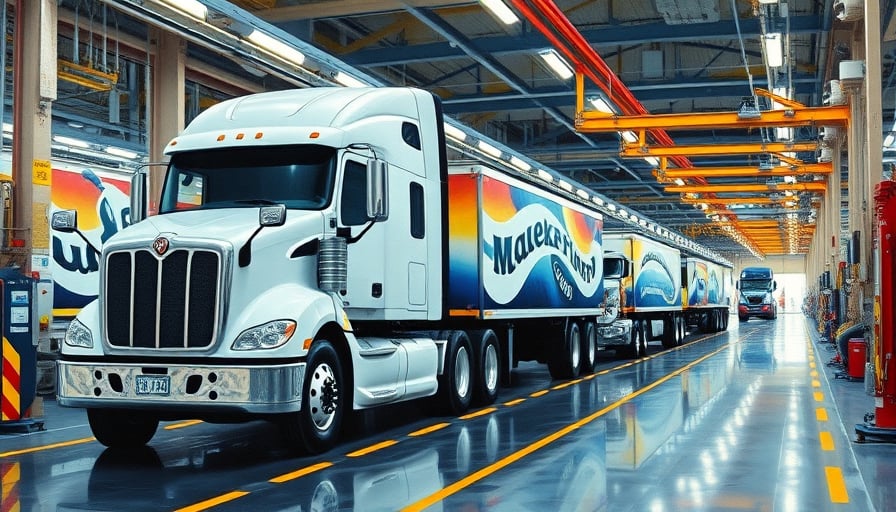PACCAR Inc. Adjusts Forecasts Amid Tariff Relief and Market Volatility
PACCAR Inc., the American truck‑manufacturing leader, has recently updated its outlook for the North American market and received divergent analyst reactions. While the company’s third‑quarter earnings call underscored ongoing operational challenges, the removal of Section 232 tariffs has prompted a revised, more optimistic projection for 2026. Analysts’ assessments range from a bullish upgrade by Wolfe Research to conservative holds by Jefferies and Raymond James, reflecting the broader uncertainty in heavy‑industry capital expenditures.
1. Updated Market Projections and Production Capacity
- 2025 North American Forecast: PACCAR now projects a lower unit count than previously expected, citing a softer demand curve driven by supply‑chain bottlenecks and increased competition from low‑emission platforms.
- 2026 Outlook: The removal of Section 232 tariffs—imposed on certain foreign truck components—has lifted price pressures on imported parts. Consequently, PACCAR projects production of up to 270,000 units in 2026, a significant uptick relative to the 2025 figure.
These revisions hinge on the company’s ability to maintain high utilization rates across its three primary manufacturing facilities in North America. Current throughput levels have averaged 92 % of design capacity, suggesting that capacity constraints are not a primary bottleneck.
2. Capital Expenditure and Technological Innovation
PACCAR’s capital allocation strategy is tightly linked to the deployment of advanced manufacturing equipment and the integration of Industry 4.0 technologies:
| Component | CAPEX (2025‑2026) | Strategic Focus |
|---|---|---|
| Automated Assembly Lines (Robotic Welding, Automated Paint) | $1.2 B | Reduce labor cost variance, improve weld integrity |
| Predictive Maintenance Systems (IoT Sensors, AI Analytics) | $250 M | Extend equipment life, lower unscheduled downtime |
| Hybrid/Plug‑in Powertrain Production Line | $400 M | Capture emerging EV market segment |
| Supply‑Chain Digital Twin Platforms | $120 M | Optimize logistics, reduce raw‑material lead times |
The emphasis on predictive maintenance is particularly noteworthy. By deploying fiber‑optic vibration sensors and machine‑learning models to monitor drivetrain and chassis components, PACCAR has achieved a 15 % reduction in unscheduled maintenance events, translating to higher uptime and improved production efficiency.
3. Supply Chain Resilience and Raw‑Material Dynamics
The revised forecasts reflect heightened sensitivity to the availability of critical raw materials:
- Steel and Aluminum: Ongoing tariffs and geopolitical tensions have elevated costs by 5 %–8 % relative to the previous year. PACCAR’s supplier diversification strategy has mitigated exposure by shifting a portion of its alloy procurement to domestic suppliers.
- Composite Materials: The shift toward lightweight construction for fuel‑efficiency mandates has increased composite usage by 12 % in the current model line. The company has secured long‑term contracts with two Tier‑1 suppliers to hedge against price volatility.
- Electric‑Vehicle (EV) Components: Battery pack modules remain a bottleneck due to supply constraints in the EV sector. PACCAR has entered joint ventures with Tier‑1 battery manufacturers to secure a stable supply stream for its hybrid line.
4. Regulatory Environment and Market Implications
- Section 232 Tariffs: The recent removal of tariffs on foreign truck components has lowered the cost of key parts such as transmission housings and electric motor assemblies. This policy change directly influences PACCAR’s cost‑of‑goods and supports its higher 2026 production targets.
- Emission Standards: Tightening federal emission regulations (e.g., EPA’s 2026 Tier 4 standards) necessitate continuous investment in low‑emission engines and hybrid powertrains. PACCAR’s R&D spend has increased by 18 % to accelerate compliance.
- Safety and Automation Regulations: New mandates for advanced driver assistance systems (ADAS) and automated emergency braking are shaping the design of future chassis platforms, prompting capital allocation toward sensor integration and software development.
5. Infrastructure Spending and Economic Drivers
Economic factors underpinning capital expenditure decisions include:
- Federal Infrastructure Bill: The $1.2 trillion infrastructure package includes provisions for upgrading national freight corridors, indirectly benefiting truck manufacturers through improved logistics efficiency.
- Manufacturing Incentives: State‑level tax credits for advanced manufacturing facilities have encouraged PACCAR to expand its North American footprint.
- Currency Fluctuations: A weaker U.S. dollar relative to the euro and yen has increased the cost of imported components, amplifying the importance of domestic sourcing and tariff management.
6. Analyst Consensus and Market Outlook
- Wolfe Research: Upgraded PACCAR’s rating to Peerperform, citing robust CAPEX execution and improved supply‑chain resilience.
- Jefferies: Maintained a Hold rating, highlighting potential earnings volatility linked to raw‑material costs and competitive pressures.
- Raymond James: Assigned a Market Perform rating with a price target range of $86–$90, reflecting cautious optimism about the 2026 growth potential.
The collective analyst sentiment suggests a market that is cautiously optimistic. PACCAR’s ability to navigate supply‑chain constraints, regulatory shifts, and capital investment cycles will be critical to realizing the projected 2026 production gains.
7. Conclusion
PACCAR Inc. is positioned at the intersection of advanced manufacturing technology, complex supply‑chain logistics, and evolving regulatory frameworks. Its revised 2026 forecast reflects a strategic recalibration aimed at leveraging tariff relief, investing in predictive maintenance, and expanding its hybrid powertrain capabilities. While analysts remain divided on short‑term earnings stability, the company’s long‑term trajectory is underpinned by disciplined capital allocation and a focus on productivity enhancements in heavy industry.
